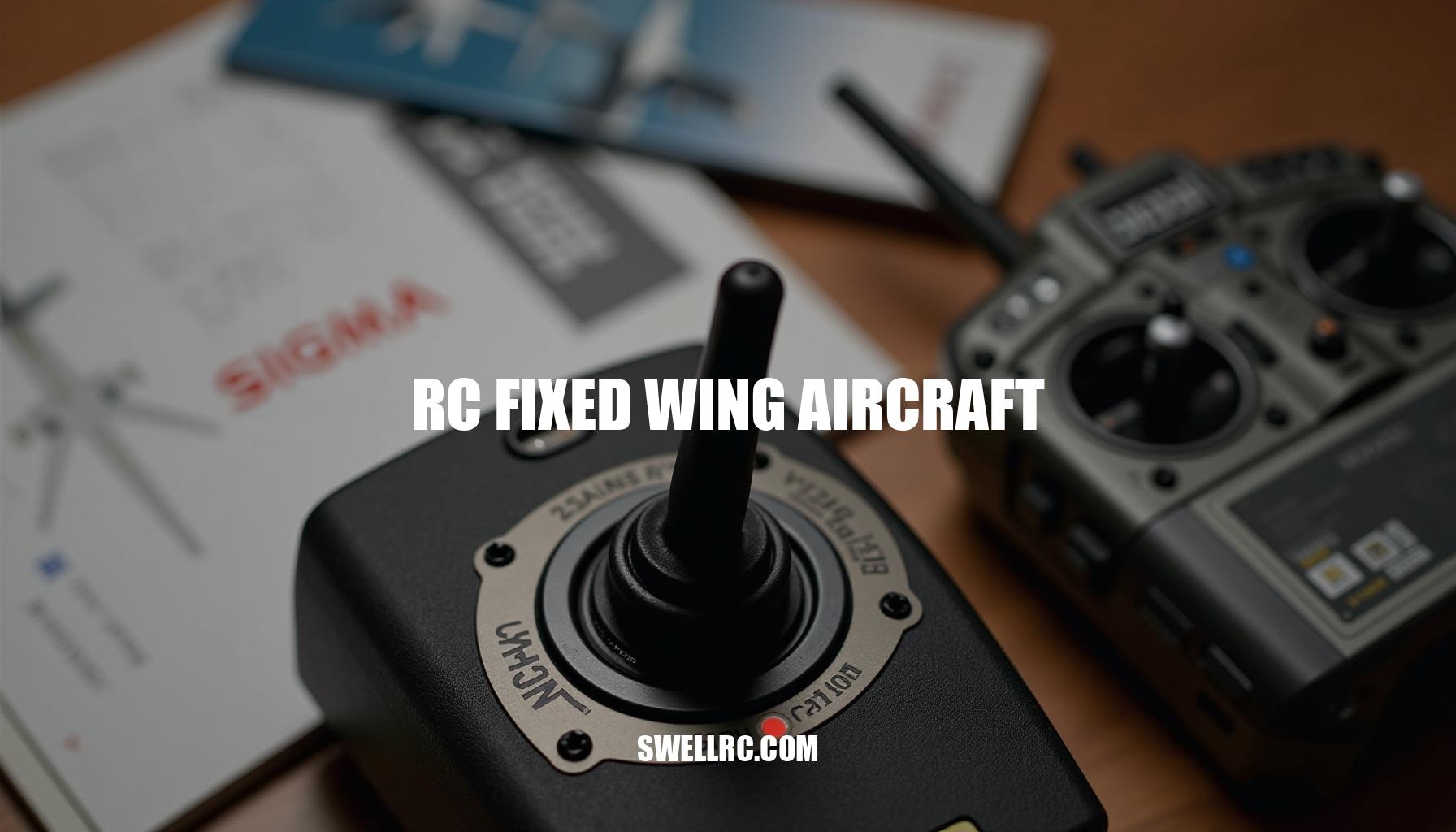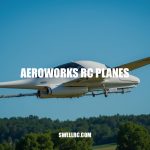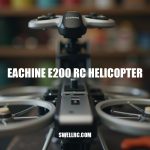Mastering RC Fixed Wing Aircraft: A Beginner’s Guide to Flight Precision
The first time I banked a foam trainer across a golden field at sunset, I felt that unmistakable mix of freedom and precision that keeps so many of us hooked on RC airplanes. These remote control aircraft are a thrilling entry point into radio control aviation, especially when you discover the unique allure of RC fixed wing aircraft. Unlike rotary models such as quadcopters and helicopters that rely on spinning rotors to hover, fixed wing flight models generate lift with stationary wings and depend on forward motion — just like full-scale airplanes.
Why do fixed wings captivate hobbyists? For me, it’s the way they reward smooth sticks and smart setup with long, graceful flights and realism you can feel. Whether you’re flying modern foam RC jets, classic balsa gliders, or nimble electric RC planes, this category offers a spectrum of speed, endurance, and style.
The appeal lies in their efficient flight times, stable handling, and scale-like silhouettes slicing the sky, providing an immersive experience unlike any other.
If you’re curious about cutting-edge design in radio control aviation, look no further than stealthy scale jets like the rc F-35. These models pack advanced aerodynamics and powerful electrics into a thrilling package that perfectly captures the excitement of fast, precision flight.
Key benefits I notice every flight include:
- Longer flight time per battery compared to most multirotors
- Stable, predictable tracking once trimmed
- Realistic silhouettes and flight envelopes that mirror full-size aviation
- Clear progression paths from trainers to fast EDF jets and precision pattern models
Exploring the world of RC airplanes, especially RC fixed wing aircraft, opens up endless possibilities for enthusiasts eager to master the skies with authenticity and skill.
Understanding RC Fixed Wing Technology
Here’s the simple, satisfying truth about how an airfoil works: it splits airflow so that pressure drops above the wing and rises below it, creating lift. When combined with thrust from a propeller or an electric ducted fan (EDF), your aircraft takes flight. The path you follow is controlled by various control surfaces—each essential for maneuvering:
- Ailerons roll the aircraft to bank left or right
- Elevator pitches the nose up or down
- Rudder yaws the tail left or right
- Flaps (optional) add lift and drag for slow, stable landings
When it comes to propulsion options, the feel of your RC plane can vary significantly:
- Electric propeller setups offer quiet, efficient flights with a wide range of battery choices, making them ideal for most pilots flying electric RC planes.
- EDF jets provide turbine-like sound and speed, though with shorter flight times and higher landing speeds—perfect for thrill-seekers ready for advanced flying experiences.
- Gas/glow engines boast long flight durations and a classic engine sound but require more maintenance and tuning, favored in traditional gas RC planes.
The materials used in your aircraft significantly affect performance and handling:
- EPO/EPP foam is lightweight, forgiving in crashes, and easy to repair—excellent for beginners and EDF jets.
- Balsa and plywood bring stiffness, lightness, and precise control but demand careful construction, offering crisp handling.
- Carbon fiber and composites deliver a high strength-to-weight ratio for top-tier performance and are often featured in premium builds.
If you’re exploring aircraft that perfectly showcase these traits, consider models like CARF RC planes, known for their precision composite builds that fly with remarkable stability and responsiveness, or Freewing planes, EDF platforms engineered for performance and easy maintenance.
Remember, as you increase speed and wing loading, sensitivity to setup and pilot input grows.
Mastering how your plane’s design, materials like foam, balsa, or carbon, and electronic components work together to influence flight feel is part of the lifelong joy of RC flying.
Categories and Types of RC Fixed Wing Aircraft
To find your groove in the exciting world of remote-controlled aviation, start by choosing the style of flying that excites you most. Here’s a practical map to guide your choice:
- Trainers (high-wing, 3–4 channels): Known for forgiving handling, slower stall speeds, and tough foam construction, trainers are the quintessential beginner-friendly option. Many quality trainers are available, such as those from World Models RC planes, ideal for those starting out in the hobby.
- Sport and aerobatic planes: Featuring medium wingspans and responsive controls, sport planes offer everyday durability and are perfect for learning pattern basics, loops, and rolls, providing an agile flying experience beyond the beginner stage.
- Pattern/precision aerobatics planes: Purpose-built for clean lines, vertical power, and stability, pattern planes allow enthusiasts to hone precision flying skills. Explore specialized RC pattern plane kits to dive deep into this style.
- Scale and military replicas: These realistic shapes and markings come with higher wing loading and approach speeds, delivering thrilling flights. Military replicas and scale models are best enjoyed once you’ve built a solid foundation in piloting skills.
- Gliders and sailplanes: With long wings and excellent glide ratios, gliders emphasize maximizing airtime and serenity. For those interested, easy-build RC balsa glider kits present a rewarding project and flight experience.
- Large-scale RC models: Offering big presence, smooth air handling, and impressive realism, large-scale RC models demand ample space, careful transport, and thorough setup, making them suited for dedicated hobbyists.
- EDF jets: Featuring jet-like sound and speed with electric ducted fans, foam RC jets are exhilarating but recommended only after mastering landings and energy management due to their high-performance nature.
Here’s a quick comparison you’ll feel at the sticks:
| Types | Characteristics |
|---|---|
| Trainers vs Sport Planes | Trainers self-stabilize and land slower, providing forgiveness for beginners; sport planes are snappier and more agile, suited for dynamic maneuvers. |
| Gliders vs Jets | Gliders maximize airtime and serenity, emphasizing smooth, extended flight; jets maximize excitement and speed, delivering adrenaline-pumping experiences. |
| Foam vs Balsa | Foam models forgive mistakes easily and are quick to repair, ideal for novices; balsa models are lighter, stiffer, and offer precise flying when meticulously built. |
Choosing the Right RC Aircraft for Your Skill Level
I learned the hard way that jumping into a sleek low-wing speedster too early turns fun into frustration, especially when you’re still mastering how to control RC fixed wing planes. To truly enjoy your flight time and improve steadily, it’s crucial to start with the best RC fixed wing aircraft for beginners — models designed with stabilization and durability in mind. A beginner-friendly plane typically emphasizes a high-wing design with some dihedral and a generous wingspan; these features foster stability by facilitating self-correction during flight.
- Stability: Selecting a high-wing model with dihedral and broad wingspan enhances self-stabilization, making it easier to practice takeoffs, turns, and landings confidently.
- Durability and parts: Foam planes, such as those made from EPO/EPP foam, outperform traditional balsa RC planes in robustness and resilience. Foam vs balsa RC planes is a critical consideration, as foam models sustain less damage and are easier to repair. Readily available spare parts keep you flying longer without frustration.
- Power system: Matching the motor and propeller to the airframe, rather than chasing top speed, helps maintain control. This ensures smoother flights and soft landings, which are vital when you’re still refining your piloting skills.
- Radio setup: Utilizing expo and dual rates reduces the sensitivity of controls, making the aircraft more manageable and forgiving to piloting errors, which is essential for beginners.
- Field realities: Considerations such as runway length, surface type (grass vs. pavement), and visibility conditions should influence your choice of aircraft and flight planning.
When exploring where to purchase or compare models, Aircraft International RC offers a broad, curated mix of airframes and setups ideal for all skill levels. If you’re drawn to nimble fighters and ready to step up, the KT RC Foam Aircraft Fighter Drone Jet is a resilient foam option worth considering.
| Skill Level | Recommended Aircraft Type | Key Features |
|---|---|---|
| Beginner | 3–4 channel high-wing foam trainer | 1.0–1.4 m wingspan, gentle stall characteristics, high stability |
| Intermediate | Low-wing sport plane or light pattern model | Add flaps, experiment with dual rates, expo, and mixing functions |
| Advanced | EDF jets, warbirds, composite pattern ships | Refine CG, thrust line, power-to-weight ratio for precision flying |
By focusing on these selection criteria—stability, durability, proper power system matching, radio setup with controllability aids like expo and dual rates, and practical field considerations—you can progress smoothly from your first flights to advanced aerobatics. Emphasizing foam vs balsa RC planes for durability and spare parts availability will ensure less downtime and more enjoyable practice each session.
Performance Tuning and Upgrades
Upgrades are where your airplane transforms from good to great, especially when focusing on critical components like ESC, motors, servos, props, and batteries. I once chased a mysterious mid-speed oscillation for weeks—turned out the center of gravity (CG) was just 5 mm aft, and the motor had a degree of unwanted down-thrust. Small tweaks matter deeply in fine tuning the thrust line and control throws to achieve optimal performance.
Core upgrade areas I track:
- Motors and props: select the KV rating and prop size/pitch carefully to ensure an efficient current draw while achieving the climb rate you desire.
- ESCs: provide sufficient headroom; a 20–30% margin above peak current keeps temperatures in check and prolongs component life.
- Batteries: choose capacity to meet your flight time goals, a C rating that can deliver punch when needed, and voltage compatible with the overall power system.
- Servos: torque and speed should match surface sizes, coupled with tight linkages and minimal slop for responsive control.
- Airframe: reinforce high-stress points using light carbon or plywood doublers to maintain durability without excessive weight.
Setup and tuning tips include:
- Balance the center of gravity exactly where the designer recommends, then fine-tune within 2–3 mm increments for perfect stability.
- Start with conservative control throws; implementing exponential (expo) settings softens the center stick feel and enhances precision.
- Check and adjust thrust angles; shimming the motor mount can correct unwanted climbs under power or nose-down tendencies.
- Always range-check your radio system and verify the failsafe operation prior to maiden flights to ensure safety.
Maintenance habits that save airframes:
- Conduct post-flight inspections focusing on hinges, horns, screws, and spars to catch wear early.
- Use foam-safe CA glue, quality epoxy, and proper surface prep for robust repairs.
- Balance props carefully to reduce vibration, protecting sensitive electronics and improving efficiency.
- Store LiPos at storage voltage and label cycles to prolong battery health and reliability.
For parts, advice, and great value finds, I frequently scan community hubs like RC Groups Classified Airplanes, where enthusiasts share upgrades, tuning tips, and maintenance strategies related to ESCs, motors, servos, props, batteries, and more.
Proper LiPo care and systematic tuning elevate your airplane’s performance significantly, turning good builds into great flying machines.
Emerging Trends and Innovations
RC fixed wing technology is evolving rapidly, making it an exciting time for enthusiasts to test the latest advancements. Modern stabilization systems now offer features like self-level, launch assist, and gyro gain profiles that feel natural rather than intrusive, greatly enhancing flight control. Digital flight controls provide pilots with real-time telemetry, including current, voltage, GPS data, and G-loads, enabling better decisions while airborne.
Hybrid-electric propulsion contributes to quieter propellers, improved ESC algorithms, and optimized motor windings, boosting both performance and efficiency. The advent of 3D-printed components allows for rapid repairs, custom ducts, and lightweight mounts, streamlining maintenance and customization. Utilizing eco-friendly materials such as tougher foams, carbon laminates, and bio-resin composites achieves strength without adding weight.
AI-assisted flight training systems serve as pattern coaches and auto-trim helpers that significantly shorten the learning curve. Meanwhile, community innovation with large-scale RC planes drives advances in reliability, structural design, and transport solutions that gradually influence smaller model development.
Conclusion: Taking Off in the RC Fixed Wing World
If you’ve read this far, you’re probably feeling the same pull that keeps me charging packs on Sunday mornings. RC fixed wing aircraft offer a unique blend of freedom and discipline—real aviation principles made tangible at your fingertips. Whether you’re a beginner learning the ropes or transitioning through advanced levels of radio control aviation, progression is key to mastering flight precision.
To start strong, begin with a forgiving trainer and master takeoffs, patterns, and landings. Match your materials and power systems thoughtfully to your goals and skill level, ensuring a smooth learning curve. Remember to treat CG (center of gravity), control throws, and thrust angles as sacred; these details profoundly affect flight precision, so tweak them deliberately.
Upgrades and maintenance are essential for safer, longer-lasting airframes. Upgrade thoughtfully—invest in quality components and regularly maintain your aircraft to keep them flying their best. Lean on the welcoming community for valuable tips, used gear, and ongoing inspiration.
From beginners to advanced enthusiasts, this camaraderie enriches the hobby.
Begin small, dream big, and relish that first smooth pass making time feel like it slows down. Brands known for craftsmanship—like the classic lines from World Models RC planes and the precision of modern composites—remind us that this hobby is global, creative, and endlessly rewarding. I’ll see you at the field.
Frequently Asked Questions
- What is an RC fixed wing aircraft and how does it work?
It’s a radio-controlled airplane that creates lift with stationary wings as it moves forward. A motor provides thrust (propeller or EDF), and control surfaces—ailerons, elevator, and rudder—steer the aircraft. Maintain enough airspeed for the wing to produce lift, and you fly; reduce speed too much, and the wing can stall. - How do RC fixed wing aircraft differ from drones or helicopters?
Fixed wings need forward speed to generate lift and cannot hover like multirotors or helicopters. They’re typically more efficient in cruise, offer longer flight times, and feel more like full-scale aviation. They usually require a runway or hand-launch and have higher landing speeds than hovering platforms. - What materials are best for building a durable RC fixed wing plane?
For pure durability and easy repairs, EPO or EPP foam is best. For light, crisp handling, balsa with selective carbon reinforcement is ideal. For maximum stiffness and performance, fiberglass/carbon composites excel but are less forgiving and more expensive. Many pilots choose foam to learn and move to balsa/composites as skills grow. - Which RC fixed wing aircraft are ideal for beginners?
A high-wing, 3–4 channel foam trainer with some dihedral and a 1.0–1.4 m wingspan is ideal. Look for stabilization modes, sturdy landing gear, and widely available spare parts. Trainers land slower, self-correct more readily, and survive minor mishaps, making them perfect for first flights. - How do you maintain and upgrade an RC fixed wing aircraft?
After each flight, inspect hinges, horns, screws, and spars; repair foam with foam-safe CA or epoxy. Keep the center of gravity on spec, balance props, and store LiPos at storage voltage. Upgrades typically focus on motor/prop matching, ESC headroom, servo torque, and airframe reinforcement. Update gyro or ESC firmware when available and keep common spares on hand.



